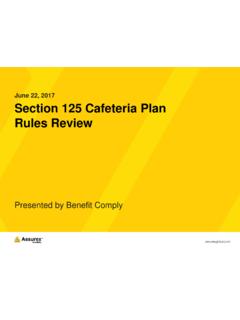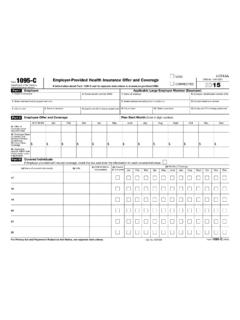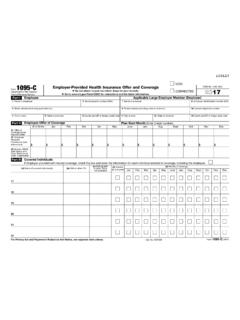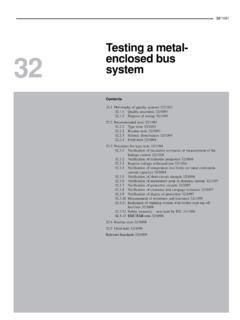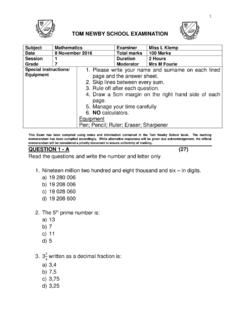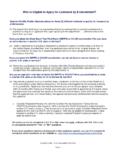Transcription of January 25, 2018 IRS §4980H Penalty Collection Efforts Why ...
1 January 25, 2018 Presented by Benefit ComplyIRS 4980H Penalty Collection Efforts &Why Employer Reporting Still MattersIRS 4980H Penalty Collection Efforts & Why Employer Reporting Still Matters Welcome! We will begin at 3 Eastern There will be no sound until we begin the webinar. When we begin, you can listen to the audio portion through your computer speakers or by calling into the phone conference number provided in your confirmation email. You will be able to submit questions during the webinar by using the Questions or Chat box located on your webinar control panel.
2 Slides can be printed from the webinar control panel expand the Handouts section and click the file to 4980H Penalty Collection Efforts & Why Employer Reporting Still MattersAssurex Global Partners Bolton & Co. Catto & Catto Cottingham & Butler Cragin & Pike, Inc. Daniel & Henry Gillis, Ellis & Baker, Inc. The Graham Co. Haylor, Freyer & Coon, Inc. The Horton Group The IMA Financial Group INSURICA Kapnick Insurance Group Lipscomb & Pitts Insurance LMC Insurance & Risk Management Lyons Companies The Mahoney Group MJ Insurance Parker, Smith & Feek, Inc. PayneWest Insurance Pritchard & Jerden R&R/The Knowledge Brokers RCM&D RHSB The Rowley Agency Starkweather & Shepley Insurance Brokerage Sterling Seacrest Partners Woodruff-Sawyer & Co.
3 Wortham Insurance & Risk ManagementAgenda IRS Letter 226 4980H Collection Efforts 4980H Applicable Large Employers (ALEs) 4980H Full-Time Employees 4980H (Employer Mandate) Requirements 6056 Employer ReportingIRS Letter 226J - 4980H Collection EffortsIRS Letter 226J - 4980H Collection Efforts IRS Employer Mandate Penalty Collection The IRS has begun to send Letter 226Js to employers to begin the Collection process for employers who failed to meet 2015 4980H requirements The first letter is a proposed assessment, not an actual Collection letter Proposed assessment based on data provided on Forms 1094-C and 1095-C Information included in Letter 226J.
4 Proposed Employer Shared Responsibility Payment (ESRP) and a summary table illustrating which months an ESRP may apply Instructions for how to respond within 30 days from the date of the letter Form 14764 Response to IRS Must sign and return to the IRS to pay or dispute proposed assessment Form 14765 - Employee Premium Tax Credit (PTC) Listing Lists employees who received a premium tax credit and how the employer coded Lines 14 and 16 of the 1095-C for each such employeeIRS Letter 226J - 4980H Collection Efforts Letter 226J Observations So far, we have only seen letters assessing penalties under 4980H(a) IRS may have decided to start with assessing 4980H(a) penalties and then move to 4980H(b) at a later date Upon appeal of 4980H(a) penalties proposed in the Letter 226J, the IRS then looks to assess 4980H(b)
5 Penalties if applicable Many proposed assessments are due to mistakes made in employer reporting rather than to an actual violation of 4980H(a) requirements Failure to mark Yes in Part III, Column (a) indicating coverage was offered to at least 70% of full-time employees each month Failure to check Box C of Line 22 indicating Section 4980H transition relief for 2015 IRS Letter 226J - 4980H Collection Efforts What Should You Do If you Get a Letter 226J? Call the number included on the top of Form 14764 and request an extension Employer has 30 days to respond unless an extension is granted IRS will initiate a Collection process if employer fails to timely respond Contact the entity (accounting firm or law firm)
6 That you use to communicate directly with the IRS for tax-related issues Contact your benefits advisor or firm you used for ACA reporting to help collect data necessary to respond to the IRS Complete and sign Form 14764 and assemble all supporting materials If choosing to dispute the assessment, include: A signed statement explaining why the assessment is being disputed; A revised Form 1094-C to illustrate appropriate changes; Coding changes, if any, on Form 14765 for the employees listed; and Any other supporting documentation 4980H Applicable Large Employers (ALEs)Applicable Large Employers (ALEs) Definition of an Applicable Large Employer (ALE).
7 Employers that had 50 or more full-time employees, including full-time equivalent employees, during the prior year Considers whether or not the employeraveraged50 or more FTEs over all 12months of the previous calendar year Example 1 = ALE Next Calendar Year:* Once calculations are done for each month and the total is divided by 12, round down to the nearest whole number Example 2 = Not an ALE Next Calendar Year:* Once calculations are done for each month and the total is divided by 12, round down to the nearest whole numberJanFebMarAprMayJunJulAugSeptOctNov DecAVG FTEs55535351525452464749525351*JanFebMar AprMayJunJulAugSeptOctNovDecAVG FTEs47484849514950484647464848*Applicabl e Large Employers (ALEs) Tips for Determining ALE Status Count all employees (including seasonal and union employees)
8 Seasonal worker exception, if applicable, is considered after the average is performed including all employee hours of service For each month, count all hours of service for any employee employed for at least one day during the month Hours of service generally include all hours paid or payable with income When there is more than one entity or employer involved due to common ownership or shared services ( a controlled group or affiliated service group under 414 rules), the entities must aggregate FTEs to determine the average for the previous calendar year.
9 If together the entities average 50 or more FTEs, then each entity is considered an ALE 4980H Full-Time Employee StatusFull-Time Employee Status 4980H Definition of Full-Time = 30 or more hours of service per week (or 130 or more per month) Hours of service generally include all hours paid or payable with income Choosing a Measurement Method Employers have the option to determine full-time status on a monthly basis or by using the look-back measurement method (averaging hours of service over a 3-12 month measurement period) An employer may only differentiate measurement methods for the following categories of employees: Hourly vs.
10 Salaried employees Union vs. non-union employees (or employees under separate collectively bargained agreements) Employees in different states Different entities within a controlled group or affiliated service groupFull-Time Employee Status Monthly Measurement Method Full-time status is measured on a monthly basis If employee achieves 130 or more hours of service during the month, employee is considered full-time If employee achieves less 130 hours of service during the month, employee is considered part-time Each month, employer needs to assess who is full-time and part-time and offer coverage accordingly This method is most appropriate for employers with most employees remaining full-time or part-time from month-to-month rather than changing back and forth Challenging to track and administer if more than a handful of employees change status from month-to-month (enroll/terminate COBRA)Full-Time Employee Status Look-Back Measurement Method Employers may average hours of service over a period of 3-12 months (the employer s choice) to determine full-time status.
